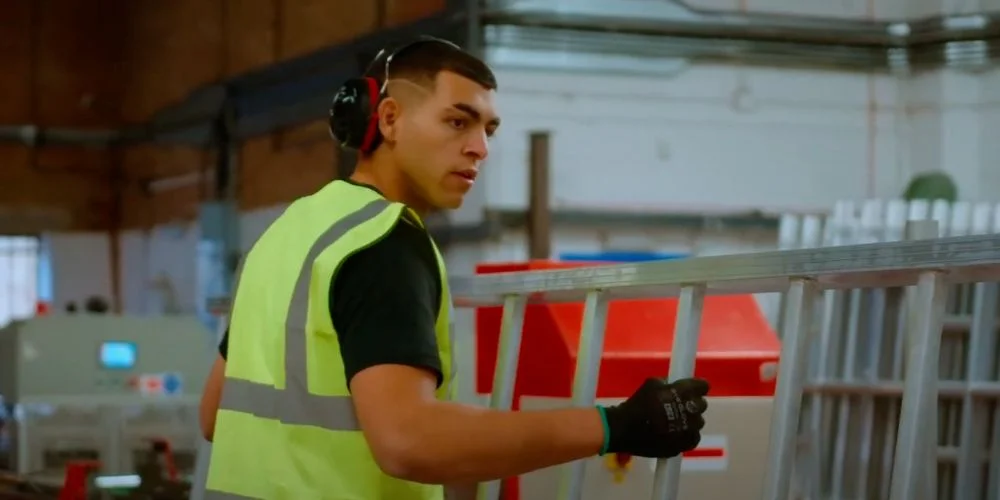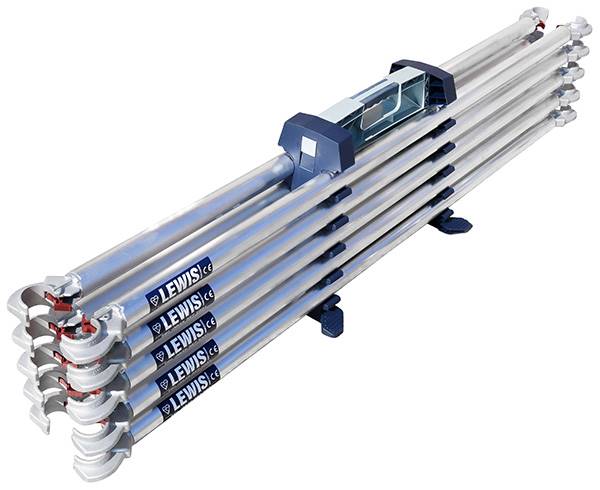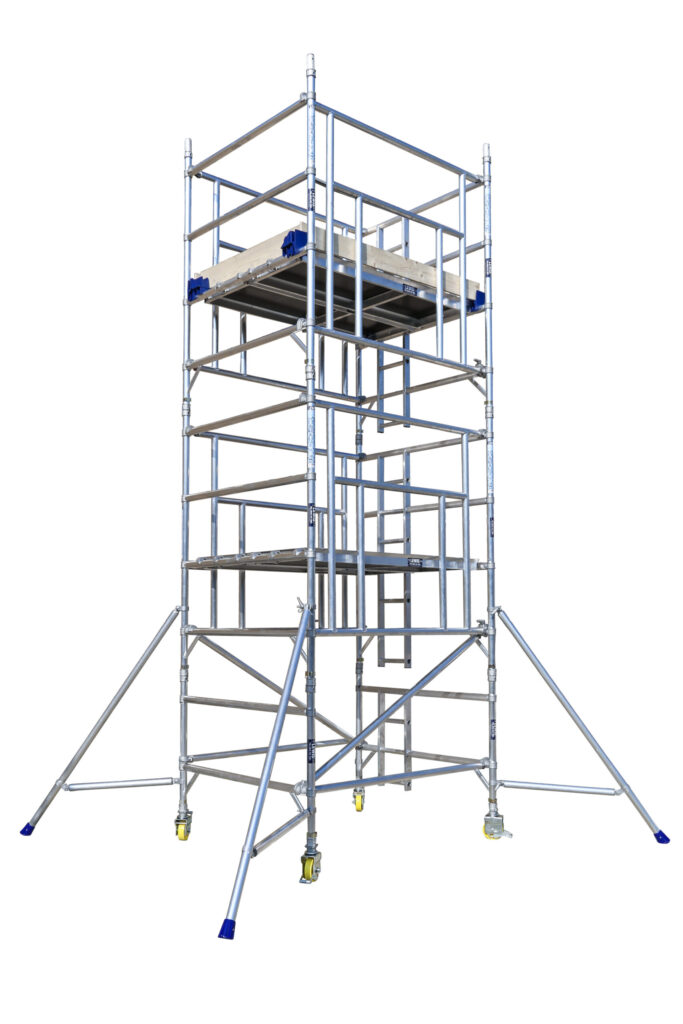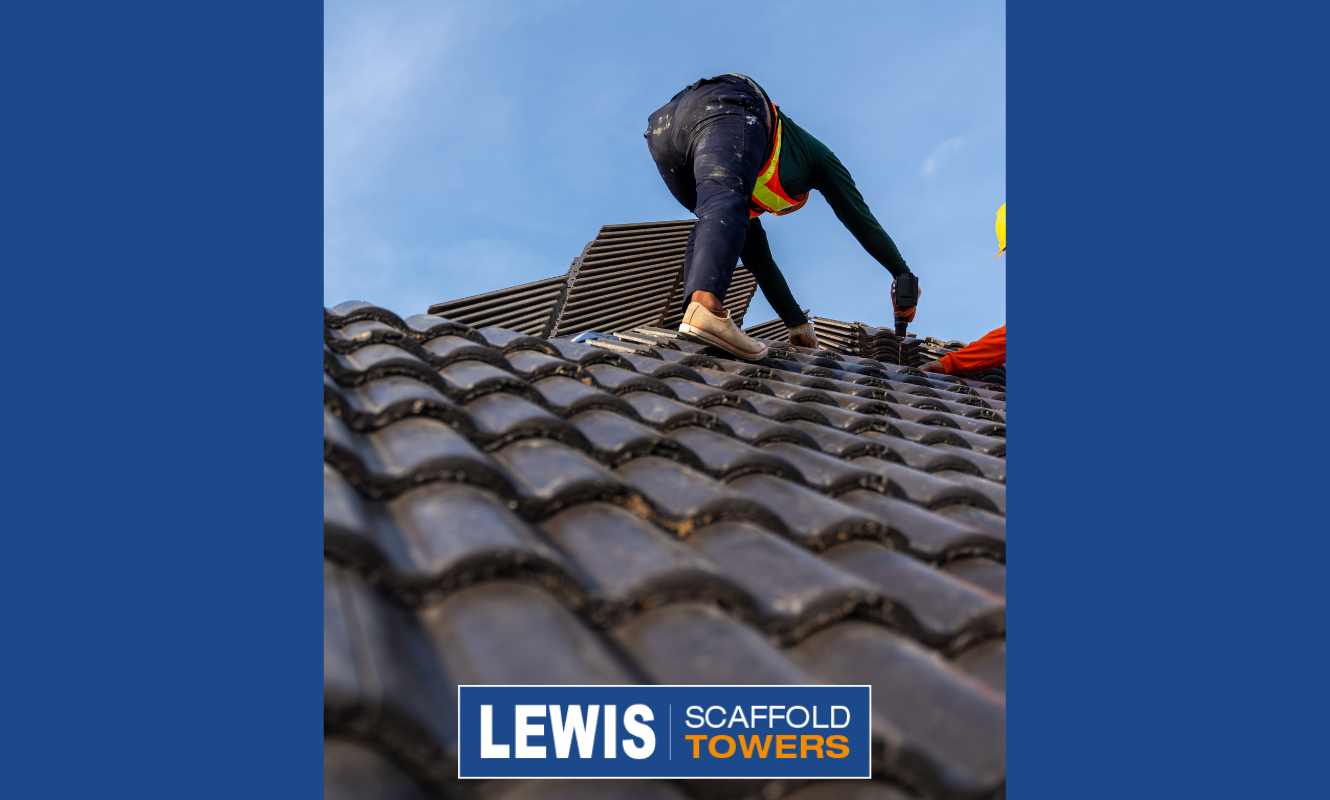When considering whether you need to use a ladder or scaffold tower for roofing, remember that a bad or rushed decision could be fatal.
The right decision will not only consider the safety of your team but also make them more efficient.
“Tragedy as man, 21, dies after falling off roof at work.
Manchester Evening News
Alfie Taylor died earlier this month after falling off a roof while at work.”

When undertaking roofing work, one of the most critical decisions is choosing the right equipment to ensure safety and efficiency.
The debate between using a ladder and a scaffold tower is ongoing among professionals and DIY enthusiasts alike.
But of course, this debate is not the only consideration when planning roofing work.
In May 2025, the Health and Safety Executive published the following article after they found this company guilty:
“A company in Manchester has been fined £20,000 after an employee fell through a roof and suffered serious injuries.”
HSE website
Th HSE found that the company had failed to ensure the work on the roof was properly planned, appropriately supervised and carried out in a manner that was as safe as reasonably practicable.
As we are British manufacturers of ladders and scaffold towers, we appreciate the importance of safety and choosing the right equipment for the job. As well as the correct planning, of course.
All our access equipment is made in our foundry according to British safety standards.
Check out this short video shot on our premises that shows you the LEWIS professional trade ladders, and read on to discover if a ladder of scaffold tower for roofing is the best choice.
A Ladder Or Scaffold Tower For Roofing?
Selecting the appropriate roofing equipment can be daunting, especially considering the risks associated with working at heights.
A scaffold tower offers a stable working platform, while a ladder provides a more portable and often more convenient solution.
The key to making an informed decision lies in understanding the specific requirements of your roofing project.
Factors such as the height of the roof, the duration of the work, and the number of workers involved all play a crucial role.
Intelligent Safety Assessment
- Assess the height and complexity of your roofing project.
- Consider the number of workers and the equipment needed.
- Evaluate the duration of the project and the required stability.
- Understand the safety implications of each option.
- Choose equipment that balances safety with efficiency.
Understanding Roofing Access Options
The choice between ladders and scaffold towers is a fundamental decision in roofing projects, impacting both safety and productivity.
Roofing professionals must consider various factors when deciding on the most appropriate access equipment for their projects.

The Importance of Choosing the Right Equipment
Choosing the right equipment for roofing access is crucial for ensuring the safety of workers and the efficiency of the project.
The wrong choice can lead to accidents, delays, and increased costs.
According to industry experts, “the right access equipment can significantly reduce the risk of falls and other accidents on roofing sites”
The importance of selecting the appropriate equipment cannot be overstated. It not only affects the immediate safety and efficiency of the project but also has long-term implications for the durability and quality of the roofing work.
| Equipment Type | Safety Features | Efficiency Benefits |
| Ladders | Portable, easy to set up | Quick access for small tasks |
| Scaffold Towers | Stable, secure platforms | Ideal for larger, more complex projects |
Overview of Ladders and Scaffold Towers
Ladders and scaffold towers are the two primary types of access equipment used in roofing projects.
Ladders are versatile and portable, making them suitable for smaller tasks and projects with limited access requirements.
Scaffold towers, on the other hand, offer a stable and secure platform, ideal for larger and more complex roofing projects.
When deciding between these options, roofing professionals should consider the specific needs of their project.
This assessment should include the size of the area to be accessed, the duration of the work, and the number of workers involved.
Both ladders and scaffold towers have their advantages and disadvantages.
For instance, ladders are lightweight and easy to transport, but they may not provide the same level of stability as scaffold towers.
Scaffold towers, while offering greater stability, can be more cumbersome to set up and may require more space.
LEWIS Access Safe Brace
Do check out the LEWIS Access Safe Brace for whatever jobs you may be taking on.

- An innovative carrying & storage device for Scaffold Tower Braces
- Carries up to ten braces, all lengths & all makes
- Allows total control when transporting
- Made from toughened lightweight plastic
- Easy storage of braces when not in use
- Transporting towers will never be easier
Ladder or Scaffold Tower for Roofing: A Comprehensive Comparison
When it comes to roofing, choosing between a ladder and a scaffold tower is a crucial decision that affects both safety and efficiency.
The right choice depends on several factors, including the nature of the roofing project, the height and complexity of the roof, and the number of workers involved.
Key Differences at a Glance
Ladders and scaffold towers are both used for accessing roofs, but they serve this purpose in different ways.
Ladders are typically more portable and easier to set up for simple tasks, whereas scaffold towers provide a more stable and spacious working platform.
This makes towers ideal for more complex or larger roofing projects.
The key differences between ladders and scaffold towers can be summarised in the following table:
| Feature | Ladders | Scaffold Towers |
| Portability | Highly portable, easy to transport | Less portable, requires more effort to move |
| Stability | Generally less stable, requires securing | More stable, provides a secure working platform |
| Work Area | Limited work area, suitable for simple tasks | Larger work area, suitable for complex tasks |
| Setup Time | Quick to set up | Takes longer to set up |
Stability and Safety Comparison
Stability is a critical factor when it comes to roof access equipment.
Scaffold towers are generally more stable than ladders, providing a secure working platform that can accommodate multiple workers and their tools.
Ladders, while useful for many tasks, can be less stable, especially on uneven or slippery surfaces.
Scaffold towers often come with guardrails and other safety features that reduce the risk of falls.
Ladders, on the other hand, require careful handling and securing to prevent accidents.

Mobility and Setup Considerations
Mobility and setup are also important factors to consider.
Ladders are typically lightweight and easy to move around, making them suitable for tasks that require frequent relocation.
Scaffold towers, while less mobile, offer the advantage of being able to be adjusted to different heights and can be configured to fit various work environments.
In conclusion, the choice between a ladder and a scaffold tower for roofing work depends on the specific needs of the project.
By considering factors such as stability, safety, mobility, and setup, roofing professionals can make an informed decision that enhances
both the efficiency and safety of their work.
When to Choose a Ladder for Roofing Work
For many roofing tasks, a ladder is the most appropriate choice, offering flexibility and ease of use.
Ladders are particularly suitable for smaller roofing projects or tasks that require accessing specific areas of the roof.
Suitable Roofing Projects for Ladders
Ladders are ideal for roofing projects that are relatively small in scale, such as minor repairs, inspections, or maintenance tasks.
They are also suitable for projects where the work area is localised, and the risk is assessed to be low.
For instance, a simple roof repair or a gutter cleaning task can often be managed with a ladder.
When considering a ladder for roofing work, it’s essential to assess the height and complexity of the task.
Ladders are generally more suitable for single-story homes or lower-rise buildings where the roof is easily accessible.
When to Choose a Scaffold Tower for Roofing
For roofing projects that require extensive access and stability, a scaffold tower is often the preferred choice.
Scaffold towers provide a sturdy and secure working platform, allowing workers to perform roofing tasks with greater ease and safety.
Scaffold towers are particularly beneficial for roofing projects that involve multiple workers or require the use of heavy materials.
Depending on the tower, they might offer a spacious working area, reducing the risk of accidents and improving overall efficiency.
Suitable Roofing Projects for Scaffold Towers
Scaffold towers are ideal for roofing projects that are complex or large in scale. They are particularly useful for:
- Roof repairs that require access to multiple areas
- Roof replacements involving heavy materials
- Roofing work that needs to be carried out over an extended period
These projects benefit from the stability and accessibility that scaffold towers provide, ensuring that workers can perform their tasks safely and effectively.
Weather Considerations
Weather conditions play a significant role in roof access safety.
High winds, rain, and icy conditions can significantly increase the risk of accidents.
Always check the weather forecast before commencing work and be prepared to postpone if conditions are unfavourable.

| Weather Condition | Safety Precaution |
| High Winds | Avoid using ladders or scaffold towers. Secure any loose materials on the roof. |
| Rain or Ice | Postpone work if possible. If not, ensure surfaces are cleared of debris and use anti-slip mats on ladders and scaffold towers. |
UK Regulations and Legal Requirements
Roofing work in the UK is subject to stringent regulations to ensure worker safety.
The industry is governed by a set of rules and guidelines that dictate the safe use of access equipment such as ladders and scaffold towers.
The regulatory framework is designed to minimise risks associated with working at heights.
Compliance with these regulations is not only a legal requirement but also crucial for ensuring the safety and well-being of workers.
Work at Height Regulations 2005
The Work at Height Regulations 2005 is a key piece of legislation governing roofing work.
This regulation mandates that work at height should be avoided unless it is absolutely necessary.
When work at height is unavoidable, the regulation requires that the work be properly planned, supervised, and carried out safely.
Employers must ensure that all work at height is properly planned and executed, with a focus on selecting the right equipment for the task.
This includes assessing the suitability of ladders and scaffold towers for the specific roofing project.
| Regulation Aspect | Requirements |
| Work Planning | Proper planning and risk assessment |
| Equipment Selection | Choosing the right access equipment for the task |
| Supervision | Ensuring competent supervision |
British Standards for Access Equipment
British Standards play a crucial role in defining the specifications and safety requirements for access equipment used in roofing.
BS EN 131 for ladders and BS EN 12811-1 for scaffold towers are examples of standards that equipment manufacturers must adhere to.
These standards cover aspects such as design, construction, testing, and marking of access equipment, ensuring that they are safe for use in various working conditions.
Ladder or Scaffold Tower For Roofing Final Words
Choosing between a ladder and a scaffold tower for roofing projects is a critical decision that impacts both safety and efficiency.
Take the time to make a wise, educated decision.
You may also enjoy How Do I Choose the Right Size Trade Extension Ladder?


